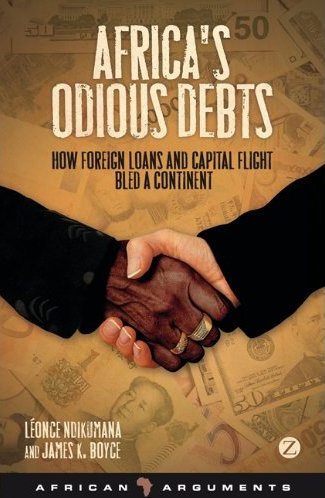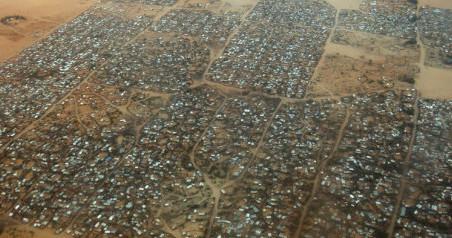AFRICAN DEBT: Funny Money and Stolen Lives – By James K. Boyce and Léonce Ndikumana

 James K. Boyce and Léonce Ndikumana are the authors of Africa’s Odious Debts: How Foreign Loans and Capital Flight Bled a Continent, forthcoming in October in the African Arguments book series published by Zed Books in association with the Royal African Society, the International African Institute, and the Social Science Research Council.
James K. Boyce and Léonce Ndikumana are the authors of Africa’s Odious Debts: How Foreign Loans and Capital Flight Bled a Continent, forthcoming in October in the African Arguments book series published by Zed Books in association with the Royal African Society, the International African Institute, and the Social Science Research Council.
The history of finance is littered with examples of the hazards of lending other people’s money and borrowing in other people’s names. Each new meltdown brings fresh reminders that financial intermediation – the vital economic function of transferring money from savers to investors – creates scope for self-dealing, fraud, and outright theft that can be curtailed only by public vigilance. In most financial crises, the victims lose their money. In Africa, some lose their lives.
Africa as a net creditor
Sub-Saharan Africa is widely perceived as being heavily indebted to international creditors including banks, western governments, and international financial institutions. Its foreign debt of roughly $175 billion amounts to more than $200 per person, a large burden in a region where the average annual incomes are under one thousand dollars. In some countries, including Burundi and the Democratic Republic of Congo, the foreign debt exceeds the nation’s total income.
What is less well known is the fact that sub-Saharan Africa experienced an exodus of more than $700 billion in capital flight since 1970. Some of this money wound up in accounts at the same banks that made loans to African governments. Africa is a net creditor to the rest of the world in the sense that its foreign assets exceed its foreign liabilities. But there is a key difference between the two: the assets are in the hands of private Africans, while the liabilities are public, owed by the African people at large through their governments.
Ins and Outs of Funny Money
Africa’s debt inflows and capital flight outflows are closely connected. As we document in our new book, Africa’s Odious Debts, there is a powerful statistical correlation between the two. For every dollar of foreign borrowing, on average more than 50 cents leaves the borrower country in the same year. This tight relationship suggests that a substantial portion of Africa’s capital flight has been debt-fuelled. Growing public external debts and private external assets are connected by a financial revolving door.
How does it work? Common mechanisms include inflated procurement contracts for goods and services, kickbacks to government officials, and diversion of public funds into the bank accounts of politically influential individuals. Some of Africa’s flight capital comes from other sources, too, such as earnings from oil and mineral exports. But foreign loans make an exceptionally easy mark in that there is no need to go through the messy business of extracting natural resources to convert them into cash.
Principals and agents
Africa’s debt-fuelled capital flight illustrates what economists call the “˜principal-agent problem.’ In fact it does so twice: first on the creditor side of foreign loans and then on the borrower side.
In creditor institutions there is a disjuncture between the interests of the depositors, shareholders and taxpayers whose money is being lent (the principals) and the interests of loan officers and their superiors who lend out the money (the agents). In theory, the agents are meant to serve the interests of the principals by making prudent loans that will be repaid with interest. But in practice, the agents are rewarded financially and career-wise for “˜moving the money,’ getting loans out the door. They may be tempted to put their self-interest first.
A similar psychology and pathology operate on the borrower side, where the agents are government officials who negotiate and disburse loans, and the principals are the citizenries on whose behalf they are supposed to act. Officials and their political bosses often borrow in the name of the government, line their own pockets and those of their cronies, and saddle the public with the debt.
Paying the price
When foreign loans come to Africa and a part of the proceeds is siphoned abroad, Africa still receives an inflow of money, albeit less than the face value of the debt. The net drain on African economies comes in subsequent years when the creditors are repaid with interest.
World Bank data on debt-service payments and public health expenditures by African governments offer stark evidence of the human costs of debt-fuelled capital flight. We estimate that an additional dollar of debt service means 29 fewer cents spent on public health. In economic parlance, the former “˜crowds out’ the latter.
Looking at the relationship between public health expenditure and infant mortality, we find that each $40,000 reduction in health spending translates into one additional infant death. Putting these findings together, we calculate that debt-service payments on loans that fuelled capital flight translate into more than 75,000 extra infant deaths each year.
It is not only money that is being stolen in Africa: it is human lives.
What can be done?
The hemorrhage of scarce resources from Africa can be stopped. Efforts by some African governments to recover wealth stolen by past officials have won international backing in the Stolen Asset Recovery Initiative launched by the World Bank and United Nations Office on Drugs and Crime. But more can and should be done to identify looters and their accomplices and to repatriate stolen funds.
Better enforcement of existing laws to curtail money laundering and new laws to strengthen safeguards are needed to staunch the outflow of illicit money from Africa into safe havens abroad. In the United States, for example, Treasury Department officials concede that banks routinely accept deposits of funds that enter the country in violation of existing laws. Moreover, the banks currently are not prohibited from handling proceeds from many activities that would be considered crimes if committed within the U.S.
More transparent information about financial inflows to African governments also can help. Just as the Publish What You Pay campaign launched by international NGOs has promoted disclosure of corporate payments for natural resource extraction, a Publish What You Lend campaign would strengthen transparency and accountability in financial markets.
Finally, African governments should be encouraged to selectively repudiate debts incurred by past regimes that cannot be demonstrated to have been used for legitimate purposes. The doctrine of odious debt in international law provides a basis for repudiation of public debts from which the public derived no benefit if the creditors knew, or should have known, this to be the case. Further legal grounds for selective repudiation are found in the principle of domestic agency in British and American law, which requires agents to act in good faith in the interest of their principals.
These steps would not only benefit Africa’s people today. They also would help to repair our international financial architecture, strengthening incentives for the exercise of due diligence by creditors and responsible borrowing by governments. Absent these reforms, “˜debt relief’ can offer only a temporary palliative. Here, as in other arenas, Africa needs justice, not just charity.
Africa’s Odious Debts will be launched by the Royal African Society at SOAS on 10th Oct. For more details click here






Dollar amounts of stolen public money are very abstract at the individual level particularly to those who are most affected by the human consequences of the vice. Billions of dollars are numbers to which they are unable to relate. This is why “stolen lives” and hence this contribution by Ndikumana and Boyce is pertinent, timely, sobering, and enthusiastically welcome.
Call it Confirmation Bias but this is one book I’ve been waiting for! More ammunition, the particular type that’s necessary to shell the hell out of all those snotty-nosed quant types.
However, from this peek preview one begins to suspect that the conical beam of the book, that catches Africa square, leaves great areas in the shadows, areas where the economies of the countries of the creditors are teeming with industry funded by stolen African money, spaces where the explanations for the long delay in the emergence of bilateral agreements to check corruption and their current halfhearted enforcement maybe found.
What percentage of capital flight from Africa returns to it as loans?
It may be hard to see at first but, ‘For every dollar of foreign borrowing, on average more than 50 cents leaves the borrower country in the same year’, begins from a standpoint of an already indebted Africa, and all answers that begin from the same stand point evade my question, or did all African countries start out as debtors? What period falls within the purview of the scope of this study, anyway?
It’s true that some African economies are almost wholly dependent on loans and others to varying degrees but,’Some of Africa’s flight capital comes from other sources, too, such as earnings from oil and mineral exports’, is so momentary a shift in focus it almost illuminates nothing else but the loans to which it immediately returns.’But foreign loans make an exceptionally easy mark–‘, one is tempted to interject, ‘For the researcher as well as the corrupt politician’. The penumbra–covering the areas relating to recommendations which relate to ‘Odious Debts’ and ‘Domestic Agency’–very much like the dawn begs for daylight.
The book is a much welcome study in any case.
[…] What’s missing from Germany’s Euro Plan? Compassion James K. Boyce and Léonce Ndikumana: Africa’s Odious Debts: How foreign loans and capital flight bled a continent Sunita Narain: In search of the right growth model Martin Khor: Palestinians win moral victory at […]
Bail Bonds Los Angeles…
[…]in the following are some urls to websites which we link to as we feel there’re worthy of visiting[…]…